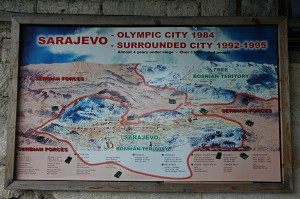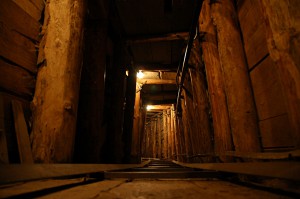After my long bus ride from Bihac to Sarajevo, I finally got to visit the city of Sarajevo last night and today. On a tour with my host for the two nights, who survived the Bosnian war in Sarajevo, I visited the tunnel museum and learned a lot about the circumstances in the city then and now.
Get a breath of fresh air! That was my first goal when I got off the completely overheated bus. Next step was to organize a city map (plan grada) and to look for a place to sleep. By a roundabout route through the old town I finally ended up in the Residence Hostel, a small jewel of a hostel in the middle of the old town, between the European and the Turkish part.
The past one and a half days were the first ones on my journey which I did not spend by myself, but which I spent with another traveler. Derek is an American who has been travelling the past 12 years all over the world and in the meantime traveling has become his profession. Please find more details about him on his own website, Wandering Earl.
Our first common goal last night was to find a place to eat. We ended up in a Muslim restaurant, where one could mainly order meat dishes. I managed to make my first big mistake in a Muslim country by asking for a large beer. Great job! The waitress politely asked for an alternative, non-alcoholic, choice.
To digest the heavy meal, we decided to walk through the city to eventually find a place to drink a Bosnian coffee. What followed was another first in my life: having to add sugar to an espresso. Had I drunk the coffee as it was, I probably would still be up two days later…
During breakfast this morning, we exchanged the plans for the day. Apparently there are many things to do and see in Sarajevo, but they are not very well advertised. We decided to go on a tour to the tunnel museum with the owner of the hostel. The tour led in the owner’s car around the city, giving explanations of what was destroyed during the war, what was rebuilt and which buildings had to be renovated.
It is really eye-opening to get all these explanations from somebody who experienced the war inside this city, and who knew where the enemy’s snipers where hiding, where one could move along safely and where one would risk to get killed.
The tunnel museum, the actual destination of our tour, was the entrance to the tunnel through which the city of Sarajevo was supplied with food, medicine and other necessary goods. The tunnel was used during most of the 4 year siege of the city by the Serbian army to bring 2000 – 3000 people in and out of the city per day. Imagine the traffic in a tunnel of a length of 800m with a height sometimes as low as 85cm and a width of about 1m. The tunnel led underneath the runway of Sarajevo airport. On either end of said runway, the Serbian army stood ready to shoot anyone who would move across. The museum itself is quite small. The building containing the museum was left in its original state after the war, so one can still see the shape in which many houses were. A video shows the conditions in the city and how the tunnel was used by the Bosnian army and police. The activities in the tunnel were supported by the people living in the city by planting vegetables in the courtyards of their buildings or on any green spot in the city, which was not within sight of the snipers.
The tour around the city also impressively showed, how four religions managed and still managed to live so close together in peace. Within a few hundred meters, one can find catholic and orthodox churches, a synagogue and multiple mosques. The inhabitants of Sarajevo are a role-model for a peaceful life among different people and religions.
Back from tour, we had again a very human goal: to get some food. We consulted our host about the restaurants which serve good Bosnian food and where we could get fresh juices. The restaurant we ended up going even served beer! Of yourse we made use of that possibility.
My intended visit to the Olympic Museum unfortunately did not take place, since the museum already closes at 3pm. I might decide tomorrow to visit the museum before taking off to Mostar.




